Fish
![]()
The title of this article is ambiguous. For other meanings, see Fish (disambiguation).
The classification of living organisms into systematics is a continuous subject of research. Thus, various systematic classifications exist side by side and one after the other. The taxon discussed here has become obsolete due to new research or is not part of the systematics presented in the German Wikipedia for other reasons.
Fish or pisces (plural to Latin piscis "fish") are aquatic vertebrates with gills. In a narrower sense, the term fish is restricted to aquatic animals with jaws. In a broader sense, it also includes jawless ones, which are still represented among recent species by the roundmouths. In both cases, at least one descendant of fishes (namely terrestrial vertebrates) is missing from their ancestral community. Therefore, fishes do not form a closed descent community in biological systematics, but a paraphyletic taxon. They are merely an incomplete descent community, consisting of a recent ancestor and the aquatic part of its descendants.
The study of the biology of fish is ichthyology (ancient Greek ἰχθύς ichthýs "fish") or fishology.
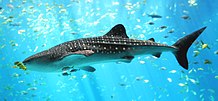
A whale shark and other marine fish in captivity outside their natural habitat
Etymology
The common Germanic noun mhd. visch, ahd. fisk has non-Germanic equivalents only in lat. piscis and air. īasc.
Systematics
In a narrower sense, fish are the jawed mouths that do not belong to the terrestrial vertebrates. Among the groups of animals living today include the:
- Cartilaginous fish with the sharks, rays and sea cats that live almost exclusively in the sea;
- Bony fishes in the broader sense, composed of flesh fins and ray fins. The flesh fins include the marine coelacanths and the freshwater lungfishes of the Southern Hemisphere. The ray-finned fishes include all other fish groups, including all European freshwater fishes.
Other fish taxa belonging to the jawmouths, but which have only survived in fossil form and have been extinct since the Palaeozoic, are represented by the:
- Placodermi and the
- Spiny dogfish (Acanthodii).
In the broader sense, also the jawless ones are counted to the fish:
- the recent cyclostomes - hagfishes and lampreys
- various extinct groups grouped together as Ostracodermi.
This results in the following internal systematics of fish (in the broader sense):
- Fish
- jawed molluscs (Gnathostomata) excluding terrestrial vertebrates (LWT)
- † Placodermi
- Eugnathostomata (pine mouth crown group) without LWT
- Cartilaginous fish (Chondrichthyes)
- Teleostomi without LWT
- † Spiny dogfish (Acanthodii)
- Euteleostomi without LWT (= bony fish (Osteichthyes))
- Ray fins (Actinopterygii)
- Meat fins (Sarcopterygii) without LWT
- Jawless (Agnatha)
- † Ostracodermi
- Cyclostomes (Cyclostomata)
- Hagfish
- Lampreys
The jawed mouths (including the land vertebrates) are a monophyletic taxon (clade), but without the land vertebrates they are paraphyletic, since they do not contain all the descendants of their common ancestor. Therefore, the taxon of fishes (in the strict sense) is paraphyletic.
The jawless are considered paraphyletic. Therefore, the taxon of fishes (in a broader sense) would also be paraphyletic, if either the jawed mouths descended from the jawless, or the other way around (both are considered plausible). This would also be true if the jawless were monophyletic, since jawed mouths (excluding terrestrial vertebrates) are already paraphyletic. However, if neither group were descended from the other, the fishes would be polyphyletic (in a broader sense), since they did not contain their most recent common ancestor.
Since fishes are not a monophyletic taxon in the sense of cladistics, they are often written in zoological systematics with quotation marks ("Pisces", "Pisces") to indicate that they are a non-monophyletic taxon.
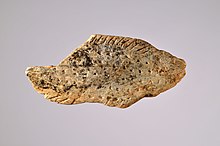
One of the oldest works of art known to mankind, fish from the Vogelherdhöhle (40,000 years old, Aurignacian), UNESCO World Heritage Site "Caves and Ice Age Art in the Swabian Jura", Museum of the University of Tübingen MUT

Copper striped butterfly (Chelmon rostratus)
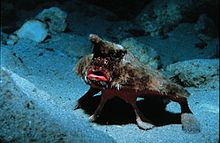
Sea bat (Ogcocephalus darwini)
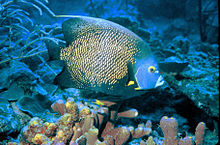
French angelfish (Pomacanthus paru)
.jpg)
Blacktip reef shark (Carcharhinus melanopterus), a representative of the cartilaginous fishes

Atlantic herring (Clupea harengus)
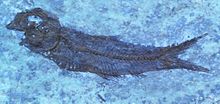
Fossil fish in limestone
Questions and Answers
Q: What are fish?
A: Fish are a group of animals with bones which live in water and respire (get oxygen) from their gills.
Q: How many classes of fish are there?
A: There are five classes of fish: Jawless fish, Armoured fish, Cartilaginous fish, Ray-finned fish, and Lobe-finned fish.
Q: Are there more species of fish than four-limbed animals?
A: Yes, there are over 33,000 described species of fish.
Q: What physical characteristics do most fishes have?
A: Most fishes have two sets of paired fins and several unpaired fins and they usually covered with scales. They are also usually cold-blooded (poikilotherm).
Q: Where do most fishes live?
A: Most fishes live in fresh water in lakes and rivers or salt water in the oceans.
Q: What is the largest type of fish?
A: The largest type of fish is the whale shark which can be almost 15 meters long and weigh 15 tons.
Q: Is the English word "fish" scientifically accurate? A:No, the English word "fish" does not fit neatly into cladistics which is the scientific way to put living things into groups; it is a paraphyletic word meaning that the animals called "fish" in English do not fit into just one phylum. Some types of fishes may be more closely related to land animals than to other types of fishes.
Search within the encyclopedia